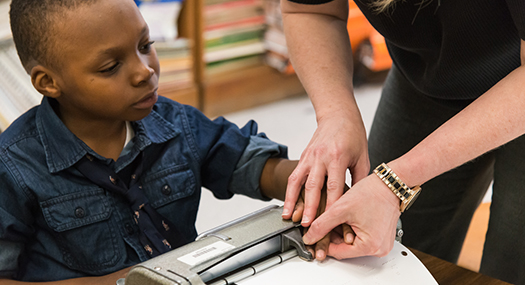Every year on January 4 we celebrate braille and the birthday of Louis Braille, the French teenager who invented it. (Learn more about Louis Braille’s life and the impact of his famous code in our online Louis Braille Museum, featuring photographs, engravings, and illustrations from books preserved in the American Foundation for the Blind's Archives and Rare Book Collection.)

Much like print, there are several ways to read and write braille. Hard-copy braille can be written with a braille writer or a slate and stylus on thick paper, plastic, or other materials. People who are blind, visually impaired, or deafblind commonly use refreshable braille displays and braille notetakers as important productivity tools in their workplaces. These devices usually have a braille or QWERTY keyboard for input and have small metal pins that raise and lower to form letters and words on a display. People who are deafblind very often use braille for reading, as well as a method of communication with others.
It’s commonly believed that braille is only used by people who are totally blind, but that’s not the case at all. Very often children with low vision are not taught braille due to a misguided belief that it’s unnecessary. Braille can be a great option for people who are visually impaired or deafblind in school, work, or everyday living. People working in the fields of music and mathematics often find braille indispensable. Some people with low vision find that the ability to read braille can be a useful asset when giving a presentation and printed notes would need to be held very close, obscuring one’s face. Similarly, rather than maneuvering to see labels of files in a drawer, braille labels make it easy to simply reach into a drawer and locate a file.
In her blog post, Is Braille Relevant in the 21st Century Workplace, Neva Fairchild shares the realization that as an adult with very low vision, she could benefit in many ways from learning to use braille. She shares that in her 40s, she learned braille out of a desire to read and write independently and that “braille contributes to my success at work on a daily basis, and it impacts my home life positively as well.”
One study found that teaching braille to children who are visually impaired “may encourage them to develop the positive lifelong habit of reading as adults, enhance their later employment opportunities, and thereby increase the possibility of financial independence.” There is a wide spectrum of uses for braille and its utility reaches from the classroom to the boardroom.
In our forthcoming Workplace Technology Study, braille devices came up frequently. Of the survey respondents, 34% were braille users and refreshable braille displays, braille embossers, and braille notetakers were examples of accommodations that some employees had requested.
Did you know that some experienced braille users find the braille keyboard faster than a QWERTY keyboard? Apple took note: iOS devices support braille entry directly on the screen, without the need for a physical braille keyboard. Learn more about the braille screen input option.
The American Foundation for the Blind has remained committed to championing braille literacy throughout the 100 years of our existence. Today, we cover new developments in braille technology through our free monthly magazine, AccessWorld, and continue to research and advocate for equitable access to education for students who are blind or have low vision.
Braille is essential to literacy for people who are blind or visually impaired, and AFB will continue to advocate for the availability of braille in every area of life. Happy World Braille Day!
